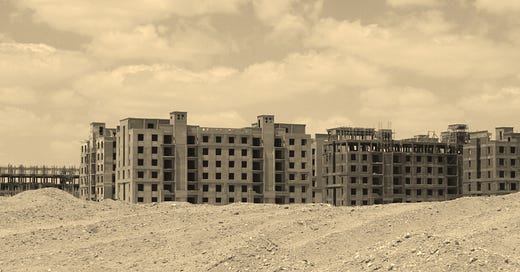BEO | Who Build Egypt's Housing 2023
An annual factsheet on housing production and real estate statistics
In the fourth annual issue of Who Builds Egypt's Housing, we analyse housing construction statistics up to the most recent year for which data is available, 2022/2023. This is the only analysis that shows the activities of all three main sectors that build housing in Egypt: The informal private sector, the formal private sector and the public sector, combining CAPMAS data on the two formal sectors with the Ministry of Electricity's data on the number of annual household subscriptions.
For the first time, the report is divided into three distinct parts: The first gives an overview of the housing sector as a whole, analysing data at the one-year, medium-term (five years) and long-term (16 years) levels. The second part focuses on the public sector, both social and investment (for-profit) housing. In the third part, the report analyses construction in New Cities versus the existing cities and villages, in the short and long term (up to ten years), as well as more detailed views of the public sector, social housing and formal private sector.
Executive Summary
Housing Overview: Big Boost in Production
- Around 1.3 million housing units were built in Egypt in 2022/2023, a 21 % jump on the previous year, and the highest number of new homes in the last five years.
- The informal private sector accounted for the lion's share of production, or 82 % of total units. The public sector came in second place, with 122,452 units or 9.1 % of the total housing stock, while the formal private sector came in third with 118,308 units, or only 8.8 %.
- The rebound in production was mostly the result of a recovery in the informal private sector, which jumped 27 % over the previous year. The formal private sector rose only marginally (3 %), with the public sector seeing a slight decline of 6 %.
- Despite this decline, public sector production remained higher than that of the formal private sector for the second consecutive year, indicating that the government has become the leading producer of formal housing units.
- Housing production exceeded the number of new marriages in three of the past five years, with an average of 22 % more units than marriages, or about 227,000 surplus units per year.
- Overall, the statistics indicate how poor and low-income people are increasingly turning to informal housing to fulfil their housing needs, in light of rapidly rising prices of formal, private and public sector housing.
Public sector: Rising for-profit, falling social housing
- Over the past ten years, several state-owned enterprises (SOEs) working in housing and real estate have produced 950,000 housing units, at an average of 95,000 units per year.
- Non-profit or subsidised housing units (social housing, slum-clearance rehousing, and cooperative housing) represented 73% of government housing production over the last ten years, at 698,354 units, or an average of 70,000 units per year.
- The social housing project known as ‘Housing for all Egyptians’ accounted for 85 % of subsidised housing or 594,571 units over ten years.
- In contrast, for-profit units comprised 27% of government production over the last ten years, or 252,947 units, two-thirds of which were built by the New Urban Communities Authority (NUCA).
- The analysis shows an unprecedented expansion of the government-built for-profit housing over the last decade, rising from 4% of production in 2013/14 to 58% in 2022/23, where production of for-profit housing surpassed that of subsidized housing for the first time in history.
- This may be indicative of a future trend where SOEs expand their activity in the real estate sector.
Comparing production in existing urban centres with New Cities
- Over the past eight years, housing production in existing cities and villages accounted for 87% of production, or 6.5 million units. On the other hand, only 13 % of housing units were built in New Cities over that time frame, or nearly one million units. This is not surprising given that the informal private sector, the largest producer of housing, builds the majority of its units in villages and existing cities.
- The government was the largest producing of housing in New Cities over the past eight years, building 576,493 of units there (58%), compared to 409,567 units built by for the formal private sector, or 42%.
- Overall, 40% of housing built in New Cities was social housing, while the rest was for-profit housing.
- This is a reflection of how the government has favoured building 78% of all its social housing in New Cities over the past eight years, over building in exiting cities and villages, as land there is state-owned desert, that is cheaper than land in existing cities.
- The formal private sector of both companies and individuals, on the other hand, built 68% of its production, or 889,554 units, in existing cities over the last eight years.
- However, this trend could be changing, where on an annual basis, formal private sector construction in New Cities surpassed that in existing cities for the first time in history last year (2022/2023), with 95,822 units, accounting for 81 % of total production during the year.
- This drastic change could be attributed to the government's imposition of exceptional zoning requirements in 2021, which significantly curtailed formal private construction in existing cities.






